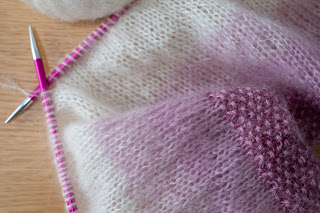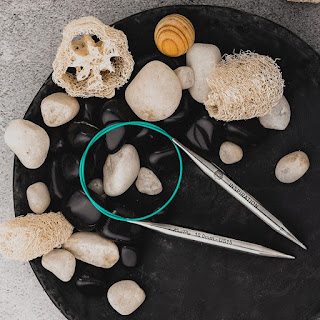Circular knitting needles are
as the name implies, crafted to knit a circle, also known as knitting in the
round. Once you are proficient in the basics of knitting, it is necessary to
begin a seamless pattern. This may appear to be daunting, but that is not the
case. Knitting in the round is an uncomplicated technique to master. The
knitting needles are connected with a cord and the length of the cord required
is based upon the number of stitches you are dealing with. If the pattern
involves an increasing or decreasing amount of stitches, then you would need to
replace the needles with either a shorter or longer cable respectively.
Knitting
in the Round with Circular Needles
Circular needles are meant to do what regular needles
cannot do: knit a smooth round tube. Items such as hats, sweaters, socks, and
mittens all consist of a circular design. The marvel of knitting in the round
is that the tube is created the instant the cast on is complete. The outcome is
a seamless tube that can be altered into any design you desire with the
assistance of increasing and decreasing.
Circular knitting needles are the most diverse needle
type available. For over a century, they have helped knit projects, whether
they be round or flat. The majority of knitters who have discovered the comfort
of circular needles stick to them permanently. These needles offer ergonomic
convenience as the needle tips are joined together with a smooth and flexible
cord of various lengths. If the needles are adjustable, then you can modify the
cord size accordingly. Even beginners are able to manage knitting with circular needles.
Here are the key points when picking the correct
circular knitting needles:
• When knitting in the round, you are always knitting on
the front of the work, as there is no need to “turn” the needle to knit on the
wrong side.
• The round technique is much faster than knitting flat.
• Knitting in the round yields a seamless tube-like
fabric. There are no seams.
Five
steps to knitting in the round:
1. Cast on using your preferred method onto the circular
needle. As you cast stitches on one needle tip and then spread it over the cord
till it gets to the other needle tip.
2. Rotate the cast on stitches so that it faces the same
direction to stop the stitches from twisting. Now you need to join the yarn so
that it becomes a round. There are many methods to join the round. You can use
a simple step such as casting an extra stitch and slipping it to the other
needle tip and join the round.
3. Ensure that the yarn is on the left hand needle tip.
Add a stitch marker to mark the first stitch of the round. You can use a round
stitch marker or if you have forgotten to place one, then use a locking stitch
marker.
4. Push the stitches near to the tips of the needles.
The rule of knitting in the round with
circular needles is the length of the needle should always be smaller than the
circumference of the project so that the stitches are not stretched.
5. Use the right needle to knit the first stitch from
the left needle and pull tight.
Additional elements to remember when choosing circular
knitting needles:
1. Always select a circular needle with a length that is
slightly less than the width of your knitting, as this allows the stitches to
flow across the needles as you knit.
2. Make sure that the stitches spread around the whole
cable and to the right-hand needle tip.
3. Before beginning to knit, double check that the
cast-on stitches are not tangled around the cable.
4. When working in the round, there is no need to turn
the work over. The right-side will always be visible.
After you’ve had enough practice knitting with a single
circular needle, then you can try out working with other methods. The magic
loop technique of knitting in the round with circular needles is used for small
circumference projects such as baby socks and clothes. As the rule of circular
knitting is the needle length should be smaller than the circumference of the
project.
Another method is knitting with two circular needles.
This technique gives freedom for working on small to large circumference
projects. Just make sure that you work with same length and size of circular
needles.
If you own a set of interchangeable circular knitting needles,
this provides much freedom as it means you do not have to purchase a new set of
needles every time you commence a new project. You are able to merge different
cables and needles to generate multiple exciting patterns and use the other
cables as stitch holders. The needles can also be used for flat patterns,
besides knitting in the round.





.jpg)



.jpg)






